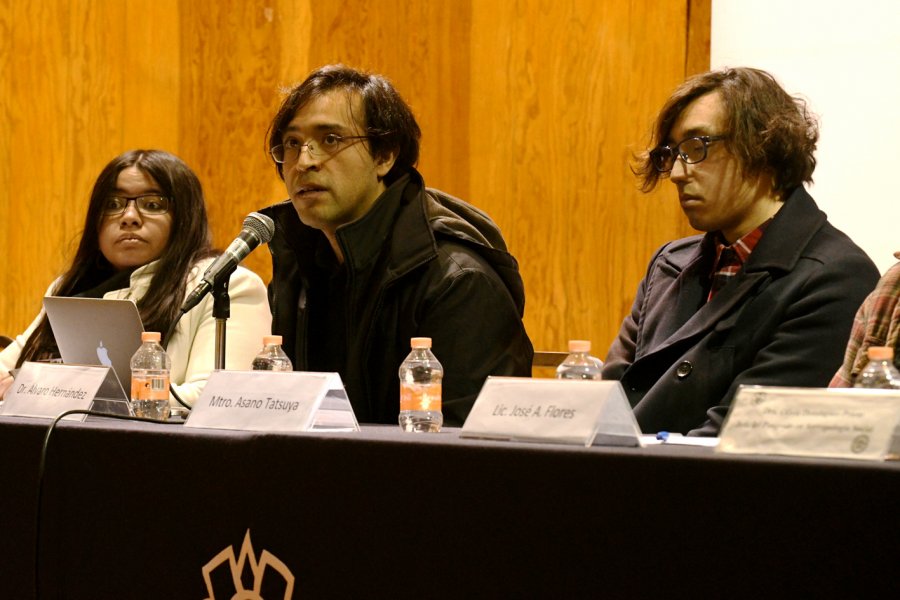Noticias
At the ENAH
The International Symposium on Comic strip, Manga and Popular Culture has started
February 01, 2018The Roman Piña Chan Auditorium of the National School of Anthropology and History hosted, on Thursday, February 1, the opening of the International Symposium Comic strip, Manga and Popular Culture: Mexico and Japan through Contemporary Popular Culture.
The goal of the meeting is to stimulate research and public discussion on comic strip in Mexico and the manga in Japan, as well as to encourage dialogue between the two countries.
The symposium is divided into six sessions: Amateur Practices, New Expressions of Popular Culture in Mexico, Mexican Comic Strip and the Japanese Manga, Consumption and Cultural Appropriation, Culture Seen through Migration Experience and Social Life of Comic Strip and the Manga..
The opening ceremony was attended by: Olivia Domínguez Prieto, head of the Social Anthropology postgraduate of the ENA; Álvaro Hernández, specialist and researcher of the International Research Center for Japanese Studies (Nichibunken); Eiji Otsuka, social anthropologist, novelist, critic, essayist, scriptwriter and author of Japanese non-fiction books; Asano Tatsuya, teacher and Manga specialist; Tadahiro Yamamoto, Manga teacher and photographer and Yuma Ishimoto, draftsman and creator.
The activities began with Session 1: Amateur practices, in which specialists Álvaro Hernández, Aidee Alejandra Vázquez Domínguez and José Alberto Flores Fajardo participated.
Hernandez presented the talk Comic strip, Manga and Popular Culture. A proposal towards translocality in which he stressed that the central theme of the symposium was to introduce young people to the evolution of comic books in Mexico.
He added that his talk sought to show the forms and similarities that the manga has had with Mexico, since, although, they are different cultures and with unequal developments, we can see that they have similarities from its history and forms of expression that in the passage of time were crossed and even merged thanks to the world context.
“When I talk about the theme of translocality, it is to understand the culture of mixtures we have now between mangas and comic strips, since the current creators always discuss if what they do is manga or comic strips, if it is Japanese or Mexican, then we should no longer be thinking so much about differentiating by country, but about seeing the rich cultural contexts that they generate.”
While Aidee Alejandra Vázquez Domínguez, a graduate in Art History and next teacher in Communication, presented the talk "Fansub, Ownership and Construction of Meaning: A Transmedia Narrative".
It was a reflection on the phenomenon of amateur translations, i. e. the practice of the fan of subtitling his favourite anime or manga productions (from his original language) into any other language to share them.
The idea is to show how members of the public are transformed into fancybers, i. e. individuals who translate works not primarily for profit, but for the pleasure of sharing.
“My aim is to show that Fansub is a fan practice characterized by cultural appropriation and how translations also appropriate the text, voice, form of speech and cultural references of fans to create meaning and generate a greater understanding of the narratives of the works”.
Finally, José Alberto Flores Fajardo, a sociology graduate and specialist in fiction, cultural and narrative industries, presented Collecting and Political Economy of Nostalgia: Saint Seiya.
In his presentation, the specialist gave a brief history and evolution of Saint Seiya (a shonen manga genre created in 1986 by Masami Kurumada who was known in Mexico as Los Caballeros del Zodiaco) which has given rise to various figures of collection that are objects of worship and desire in Mexico and the world.
The sociologist also approached concepts related to collecting and economics, as well as nostalgia "understood as a feeling of sadness and melancholy caused by the memory of a lost joy that has been transformed and widely used in the age of consumerism”.
The specialist added that industrial designers of the U. S. avant-garde have seen memory and nostalgia as an effective tool for profit and based on these concepts they have created products capable of being imprinted on the consumer's memory.
In his book, All Images of Consumerism: The Politics of Style in Contemporary Culture, Stuart Ewen quotes Henry Dreufus, a famous designer who said that almost without exception products include an ingredient we call a surviving form, an evocative detail that will remind users of a similar article”.
“People will adapt to something new, we believe, if they recognize in this object something that comes from the past. For that, you have to include a familiar pattern in a new and radical way, which makes it acceptable to something they would otherwise reject”.
The International Symposium on Comic Strip, Manga and Popular Culture: Mexico and Japan through Contemporary Popular Culture will be held until February 4 in three venues: the National School of Anthropology and History, El Colegio de México and the Vasconcelos Library.
For further information please visit at: http://www.bibliotecavasconcelos.gob.mx/detalle-actividad/?id=185592
Mexico,Distrito Federal
